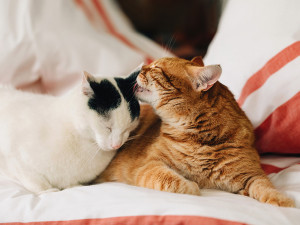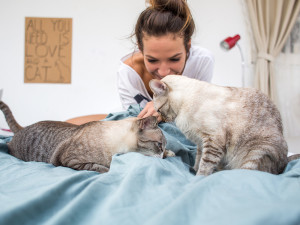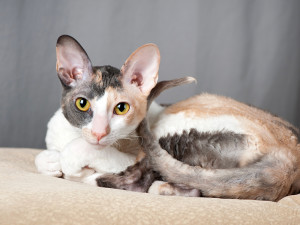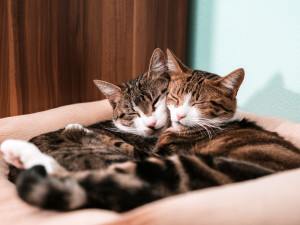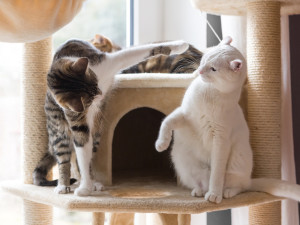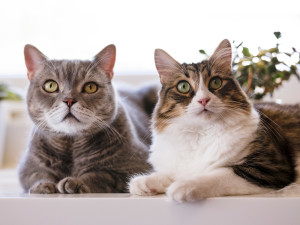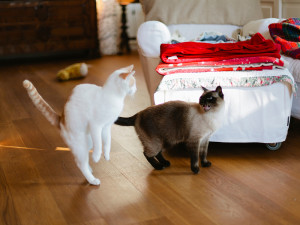Why Does My Cat Hate Other Cats?
And how to quell the hate.

Share Article
In This Article:
Why Does My Cat Hate My Other Cat? What Causes Aggression Between Cats How To Help Your Cat Get Along With Other Cats
When your cat sees another cat, what’s the first thing they do? Do they initiate a play session? Or do they let out a long, loud hiss, signaling they want absolutely nothing to do with another kitty? Does your cat hate other cats? That’s maybe OK if no other cats actually live in your house, but if your cat has to share space with another feline, there could be trouble — for them and for you. But it doesn’t have to be like that.
Here’s what you need to know.
Why does my cat hate my other cats?
I work with clients every day who are frustrated and confused by their cats not getting along. They don’t understand how these creatures who can be so loving and playful with them can seemingly hate each other. It can range from mild nervousness to extreme fear. Some cats may be aggressive. Others may hide for da ys at a time. You may even have experienced your cats getting aggressive with you when tensions are high between them.
How much do you spend on your pet per year?

This is all very normal and reasonable behavior if you’re a cat who doesn’t feel safe or in control of their situation. The good news is that you can work on their relationship. They may not be best friends. But if you can help them coexist peacefully, everyone will feel better.
What causes aggression between cats
I think “hate” is the wrong word when talking about cats. It feels too personal, like they’re making a choice to dislike another cat. It’s more about instinct and the situation a cat is in that makes them aggressive toward another cat. Let’s look at some of the triggers that can cause aggression.
Territorial behavior and resource competition
Cats can share territory and still avoid each other. But when they come face-to-face, things can get serious. Why? It goes back to instinct. Stranger danger. In the wild, a stranger cat puts them in physical danger. Their food, water, and other resources can be stolen. They can be driven off. It’s not a good scene.
The same is true in your living room. If a new cat suddenly shows up without a proper introduction, or your cats have never gotten along, those same instinctual concerns kick in. This cat could hurt me, eat all my food, take over my person and my favorite sleeping spot, and drive me away.
Maternal aggression
Mamas protect their babies. It can happen if you have a stray litter outside and your cat gets too close, or a mom and babies inside with other cats in the home. Even some adult cats will be protective of their cat buddies if they’re threatened.
Play-aggression
Play-aggression is extremely common, especially if you have cats with different energy levels. It’s frequently mistaken for defensive aggression, and often leads to it. Play-aggression just means one cat is playing way too intensely for the target of that play.
The cat who isn’t in the mood for a lot of play gets defensive as a way of trying to stop the interaction. Then the play-aggressive cat feels they need to get defensive right back. Now, you’ve got two cats who have learned that being around each other is no fun.
Lack of socialization
Cats who have positive relationships with other cats, especially early in life, may do better with all cats generally. They learn from the start that being around other cats means good things happen for them.
However, this is not a guarantee. There are many things that can influence the way two cats get along, regardless of socialization. Even a cat who wasn’t positively socialized to others can still get along well with another cat in the right environment and with the proper introduction.
Unrelated stress (such as medical issues)
So many things can cause stress for a cat. Stress increases reactivity, making them more sensitive to each other’s presence and actions. That means reducing stress, even if it’s unrelated to the other cat, can actually help them get along better. It’s a significant part of relationship work.
Here are just a few things that can cause stress:
Medical issues, pain or discomfort
An environment that isn’t meeting instinctual needs well, such as a poor litter box set-up or not having access to food often enough
Lack of play and enrichment
Relationship issues with other pets or people in the home
Changes in routine
General fear or anxiety
Specific triggers, like loud sounds or strangers, that happen frequently and cause fear
Personality differences between the cats
It may be less about personality and more about energy levels. It’s not that one cat doesn’t like another’s bad jokes or thinks they gossip too much. But one may be super active, wanting to chase and pounce on anything that moves and the other prefers to nap in the sun and bat at a wand toy. This happens a lot with kittens and older cats.
If they don’t do a good job of setting and respecting each other’s boundaries, there’s likely to be some aggression.
How to help your cat get along with other cats
If your cats can share space well at times but have aggressive interactions here and there (even daily), there are some simple things you can do to help. This also works if your cats have gotten along well for years but now one cat suddenly seems to dislike the other.
On the other hand, if your cats can’t share space at all without fighting, your best bet is to start fresh by separating them and going through a careful, slow reintroduction as if they’ve never met.
Environment and resources
Look at your cats’ resources: food, water, litter boxes, high space, hiding spots, scratchers, beds and toys. Do you have multiples and are they spread throughout your home for easy access?
Play and enrichment
Two of the best ways to reduce stress and meet instinctual needs are daily play sessions and lots of mental enrichment, like food puzzles, bird watching, and training.
Build a group scent
When cats live together, they often groom each other. This creates a group scent that they all share. It’s the primary way they recognize each other as safe members of the group. Helping your cats create a group scent can improve their relationship.
Use a soft bristle brush or clean cotton sock to rub the cheeks and shoulders of each cat. Add a treat so they’re building positive associations with that scent. Do this daily for a couple of weeks. Fade it out as things improve.If any of the cats don’t like being rubbed or brushed, don’t force it.
Use positive reinforcement
Positive reinforcement just means you’re using something your cat enjoys (pets, treats, tossing a toy, verbal praise, etc.) to reward them for behaviors you want to see more of. In this case, you can reward any positive interactions between the cats. If they boop noses, sit near each other, play together, sleep on the same bed, etc., reward it.
You can also reward neutral interactions, where they have no reaction at all to each other. Ignoring each other as they pass in the hall, one jumping on the couch where the other is and neither one caring, one staying calm while the other is running around, etc.
Fun time together
At least once a day, bring them together for a positive experience. Maybe it’s a treat or play session. One gets pets while the other works on a food puzzle. Whatever they enjoy is fine. They’re just doing it near each other, and learning that when the other cat is around they get good things.
Limit fights
The most important part is stopping negative interactions as quickly and calmly as possible. It doesn’t matter how much good stuff you’re doing. If they still fight once a day you won’t make much progress. Watch for early cues that they’re about to get upset with each other. If you can catch them before things turn negative, use anything positive to pull their attention away from each other. Toss a toy or treat, call them over for pets, etc.
If they’re already having a negative interaction, don’t use the positive distractions above, or punishment (which never works). Instead, use a neutral distraction—something that is neither good nor bad. It’s just a thing that causes one or both to say, “Hey, what was that? Better go check it out.”
Try covertly tossing something in the opposite direction (not like play, but just a casual toss). Or make a gentle sound, like knocking on the table or rattling a jar of dry beans. You can also try blocking their sightline with a piece of cardboard, pillow or blanket. That may be enough to get them to walk away.
Wait a minute or two after they’re distracted. Then give them something to do to burn off that energy. Play, food puzzle, etc. This will help keep them from going back after each other.
When to seek expert help
If you’re not having any luck improving things between your cats, a certified feline training and behavior consultant can help. It’s important to work on the issue so it doesn’t negatively impact their quality of life, especially if there’s extreme fear or aggression happening.
Your cats don’t need to live in fear of each other. There’s so much that can be done to try and help them feel safe and secure. An expert can help.
References
“Conflict between Cats | Indoor Pet Initiative.” Indoorpet.osu.edu, indoorpet.osu.edu/cats/problemsolving/conflictopens in new tab.
Cornell Feline Health Center. “Feline Behavior Problems: Aggression.” Cornell University College of Veterinary Medicine, 9 Oct. 2017, www.vet.cornell.edu/departments-centers-and-institutes/cornell-feline-health-center/health-information/feline-health-topics/feline-behavior-problems-aggressionopens in new tab.
“Feline Behavior Problems: House Soiling.” Cornell University College of Veterinary Medicine, 23 July 2018, www.vet.cornell.edu/departments-centers-and-institutes/cornell-feline-health-center/health-information/feline-health-topics/feline-behavior-problems-house-soilingopens in new tab.
“Even Healthy Cats Act Sick When Their Routine Is Disrupted.” Even Healthy Cats Act Sick When Their Routine Is Disrupted , The Ohio State University, 2 Jan. 2011, news.osu.edu/even-healthy-cats-act-sick-when-their-routine-is-disrupted/opens in new tab. Accessed 10 Feb. 2025.
“When Is Your Cat Hiding Illness or Injury?” VMBS News, 14 Sept. 2017, vetmed.tamu.edu/news/pet-talk/when-is-your-cat-hiding-illness-or-injury/opens in new tab.

LeeAnna Buis, CFTBS, FFCP
LeeAnna Buis has adored cats her entire life and thought she knew them inside out and sideways. But it wasn’t until she worked with a feline behavior consultant that she fully understood how incredible, complicated, and inspiring they really are. She made a career change, starting the certification process to become a behavior consultant right away. She discovered what unique, fascinating, complex creatures cats are and knew this was what she wanted to do with her life — help others on a similar journey to truly knowing, loving, and appreciating their cats.
LeeAnna earned her certification through Animal Behavior Institute, where she received the certified feline training and behavior specialist (CFTBS) designation.
Related articles
![Cornish Rex cat laying down on a pillow]()
The Cat Breed-Behavior Connection
Which cats are more likely to have stranger danger? Bite the hand that feeds them? Do the zoomies? Scientists studied 5,700 pet cats and discovered some interesting traits.
![Two tabby cats in embrace lying in cushion.]()
What Are Cat Pheromones and How Do They Work?
Communication is key, and pheromones are your cat’s version of DMs.
![Gray striped cat and white cat playing on cat tree.]()
Are Your Cats Playing or Is This a Full-On Scar Vs. Simba Fight?
A recent study breaks down the difference.
![Male and female cat lying side by side.]()
How to Spot the Difference Between Male and Female Cats
There’s more to it than what you learned in health class.
Do Cats Grieve When Other Cats Die?
And you can best comfort your sad kitty.
![Two cats in a living room that appear to be arguing.]()
Me-OW! Should I Break Up a Cat Fight?
Between actual cats, people.

